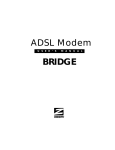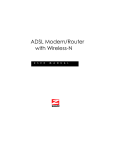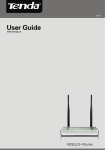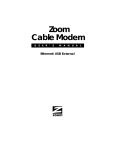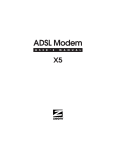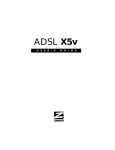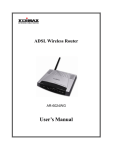Download ADSL X5 User's Guide
Transcript
ADSL X5 U S E R ’ S G U I D E NOTICE This document contains proprietary information protected by copyright, and this Manual and all the accompanying hardware, software, and documentation are copyrighted. No part of this document may be photocopied or reproduced by mechanical, electronic, or other means in any form. The manufacturer does not warrant that the hardware will work properly in all environments and applications, and makes no warranty or representation, either expressed or implied, with respect to the quality, performance, merchantability, or fitness for a particular purpose of the software or documentation. The manufacturer reserves the right to make changes to the hardware, software, and documentation without obligation to notify any person or organization of the revision or change. All brand and product names are the trademarks of their respective owners. © Copyright 2004 All rights reserved. Contents OVERVIEW ................................................................................4 CHAPTER 1: INSTALLATION INSTRUCTIONS ............................5 INSTALLING THE X5........................................................................... 8 REMOVING THE X5 SOFTWARE ..................................................... 27 UNIVERSAL PLUG AND PLAY .......................................................... 28 IF YOU NEED HELP.......................................................................... 28 CHAPTER 2: STATUS MONITORING .......................................29 WHY MONITOR STATUS? ................................................................. 29 MONITORING SYSTEM STATUS....................................................... 30 MONITORING ADSL STATUS ......................................................... 31 CHAPTER 3: ADVANCED SETUP OPTIONS..............................32 HOW TO USE THE ADVANCED OPTIONS .................................... 33 CHANGING YOUR WAN SETTINGS .............................................. 38 CHANGING YOUR FIREWALL SETTINGS ...................................... 39 CHANGING USER NAMES AND PASSWORDS ................................ 40 BACKING UP YOUR CONFIGURATION ......................................... 41 RESETTING DEFAULT SETTINGS ................................................... 43 USING IP FILTERS ............................................................................. 44 APPENDIX A: ADSL INTERNET SETTINGS TABLES ..............45 APPENDIX B: FRONT AND BACK PANELS ..............................48 APPENDIX C: TCP/IP NETWORK SETTINGS.........................50 APPENDIX D: TROUBLESHOOTING .......................................57 APPENDIX E: CONFIGURING YOUR BROWSER ......................62 APPENDIX F: REGULATORY INFORMATION ..........................66 Overview The X5 integrates an ADSL modem, a router, and a four-port switch in one device. It includes an advanced firewall, which allows you to control Internet access from your local network, and which protects your local network from unwanted Internet traffic. With four LAN ports (labeled 1, 2, 3, 4), the X5 supports the direct connection of up to four computers with Ethernet ports. Those with a network device (such as a wireless access point) can plug it into one of the LAN ports to support up to 253 Internet connections. (There is also a USB port for Windows computers that do not have an Ethernet port, or for Windows users that want to connect five computers directly to the modem.) The X5 modem is also enabled for Universal Plug and Play (UPnP™). This means that if you plug other devices with UPnP capabilities into your computer or network (for example, a gaming application, router, or stand-alone firewall) they should automatically detect the X5 and make the needed configurations for them to work together. This User’s Guide contains installation instructions for Macintosh, Linux, and Windows computers, and information about the X5’s advanced setup options. While most users will not need to use the advanced setup options, there are cases in which these advanced settings are necessary (for example, if you have a static IP address). Overview 4 1 Installation Instructions This chapter covers the basic instructions needed to install your X5 and connect to the Internet. These instructions can be used by those with a Macintosh, Linux, or Windows operating system. If you already installed and connnected your X5 (using the separate Quick Start booklet provided for Windows users), you can skip this chapter and begin with Chapter 2. Package Contents Your package contains the items shown below: Zoom X5 ADSL Modem USB Cable Phone Cord Power Cube Ethernet Cable Software CD-ROM The CD contains the installation software, documentation, warranty, and Customer Support information. Chapter 1: Installation Instructions 5 If anything is missing or damaged, please contact Zoom Customer Support or whoever sold you the modem. In addition, the package may include: • Phone-jack adapter to adapt the phone cord to a particular phone jack (certain countries only) • ADSL line filter(s) (certain models only) Before You Begin Before you begin installing the X5 modem using this guide, you must have the following available to you: • ADSL service enabled on your telephone line. To do this, you need to sign up with an ADSL service provider. Once this service is enabled, you should have an ADSL-enabled telephone wall jack to plug the X5 modem into. (Your service provider may refer to “ADSL service” as “DSL service.”) • One or more computers that you want to connect to the Internet. The X5 supports the connection of up to four Macintosh, Linux, or Windows computers with Ethernet ports. Note for Windows users: Your computers must use one of the following operating systems: Windows 98/Me/2000/XP. We recommend that you connect all of your Windows computers using Ethernet ports. If any of your computers do not have an Ethernet port, you can purchase a Network Interface Card (NIC) to add one. Alternately, you can connect one of your computers using its USB port. (This also enables Windows users to connect five computers, instead of four, directly to the X5.) 6 ADSL X5 User's Guide • [Optional] Network device: You can connect a network device (such as a wireless access point, router, hub, or switch) to the X5 modem. If you plan to connect a network device, be aware that you must first connect at least one of your computers directly to the X5. This will be the computer from which you will configure the modem. (For Windows users, this will also be the computer on which you will install the software.) Note: Because network devices can be set up in many ways, this user’s guide provides general instructions about connecting a network device to the X5. For information about setting up your network device, see that device’s documentation. • Additional Ethernet cables. These are only required if you plan to connect more than one computer/network device with an Ethernet port to the X5. (The X5 comes with one Ethernet cable and one USB cable.) Chapter 1: Installation Instructions 7 Installing the X5 Installing the X5 involves four steps: Installing the Software, Installing the Hardware, Establishing Communication, and Connecting Additional Computers to the Internet. Step 1: Installing the Software Important! This section is for Windows computers only. If you are using a Macintosh or Linux computer (or you are a Macintosh or Linux user who is connecting the X5 directly to a network device), skip this section and begin with the next one, Installing the Hardware on page 10. Regardless of how many Windows computers you plan to connect to the X5, you only have to install the software on one of them. The Windows computer on which you install the software will also be the first computer that you physically connect to the X5. It will also be the computer from which you configure the modem. (The hardware connection and the modem configuration process are explained later in this user’s guide.) Determining which computer to install the software on depends on how the computers will be connected to the X5: • If all of your Windows computers will be connected using their Ethernet ports: You can install the software on any one of these computers. • If one of the Windows computers will be connected using its USB port and the rest using their Ethernet ports: You must install the software on the computer with the USB port. Because the back panel of the X5 modem has one USB port and four LAN (Ethernet) ports, only one computer can be connected using a USB port. Note, however, that we recommend you connect your computers using Ethernet ports, if possible. 8 ADSL X5 User's Guide • If you will be connecting a network device (such as a wireless access point, router, hub, or switch): You must install the software on a Windows computer that will be directly connected to the X5. This means that if you have a network device, you should choose a computer to connect to the modem (the actual physical connection will be made later in this user’s guide) and install the software on it. For most users, this will probably be the computer that is closest to the ADSL-enabled phone jack. If you were already planning to connect multiple computers directly to the X5 (in addition to a network device), review the previous two bullets to determine which computer to install the software on. Windows computer users MUST install the software BEFORE installing the hardware. Important! If you need to use the X5’s USB option, you must remove any existing USB modem drivers on your Windows computer before installing this software. On the desktop, click the Start button, and then—depending on your operating system—either click Control Panel, or click Settings and then Control Panel. In the Control Panel, double-click Add/Remove Programs. On the Add/Remove Program Properties dialog box, select the USB modem you are removing on the Install/Uninstall tab, click Remove, and then click OK. 1 Turn on your computer (if it is not on already). 2 Insert the supplied CD into the CD-ROM drive of your computer. The CD should start automatically and the Language Selection screen should appear. (If the CD does not start automatically, on the desktop, click the Start button, click Run, and then type D:\setup.exe, where D is the letter of your CD-ROM drive.) 3 Select your language. The Main Menu screen opens. Chapter 1: Installation Instructions 9 4 Click Installation Wizard. 5 Click ADSL X5 Modem to start the software installation, then click Next when prompted. 6 When the installation is complete, click Finish, then click Exit. 7 Close any applications that may be open, then remove the CD from the CD-ROM drive. 8 Shut down the computer. Congratulations! You have installed the software. Now, continue with the next section, Installing the Hardware. Step 2: Installing the Hardware Windows users only: Be sure that you have already installed the software BEFORE beginning this section. Software installation is not required for Macintosh and Linux computers. 1 Shut down your computer (if it is not shut down already). ! For Windows users, this is the computer on which you just installed the software. ! For Macintosh or Linux users, this can be any one of the computers that you plan to plug directly into the X5. If you plan to use a network device (such as a wireless access point, router, hub, or switch) you must connect at least one of your computers directly to the modem. 10 ADSL X5 User's Guide 2 Connect the modem to the computer’s Ethernet jack. If you are using a Windows computer, you have the option of connecting your computer’s USB port. However, Windows users should only be connecting to a USB port if your computer does not have an Ethernet port or if you plan to plug five computers directly to the X5 modem. ! If you are using an Ethernet port: Plug one end of the Ethernet cable into one of the X5 modem’s LAN ports (1, 2, 3, or 4) and plug the other end into your computer’s Ethernet port. Important! Do not connect additional computers or a network device (such as a wireless access point, router, hub, or switch) to the other LAN ports at this time. These instructions will let you know when to connect them. ! If you are using a USB port (Windows computers only): Plug one end of the USB cable into the modem’s USB port and the other end into your Windows computer’s USB port. The connection is made to the back panel of the modem. 3 Plug the included X5 power cube into a power strip or wall outlet, and then into the modem’s power (PWR) jack. Important! Only use the power cube shipped with the X5. Other power cubes may damage your hardware. The PWR light on the front panel of the modem should become steady on, and the ADSL light should blink once. If the PWR light does not turn on, make sure there is power at the wall outlet or power strip where you plugged in the power cube. Chapter 1: Installation Instructions 11 4 Turn the computer on. Windows users who connected their computer to the USB port may see a Found New Hardware box indicating the progression of the installation. Typically no user action is necessary. If you are using Windows XP, you may be required to click Next. Depending on your operating system, you may also see a Hardware Installation box or a Digital Signature Not Found box. You can safely ignore these messages and click Yes or Continue Anyway. If prompted, click Finish and/or Yes to restart your computer to finish setting up your new hardware. 5 Plug one end of the supplied phone cord into the modem’s ADSL jack and the other into the ADSL wall jack. The ADSL light should blink and then become steady on. If it does not, refer to Appendix D: Troubleshooting on page 57. 6 We HIGHLY RECOMMEND that you install a filter on EVERY phone and fax machine that is sharing the ADSL phone line. (Do not plug a filter between the wall jack and the X5.) Phone filters block the ADSL frequencies so that someone making a normal phone call will not hear modem noise on the line. They also keep phone conversations from interfering with ADSL performance. You may have received ADSL phone filters with your X5. If you did not, or if you need more filters, they are available at most retail stores that carry consumer electronics. For each filter, plug the phone or fax machine’s cord into the filter’s PHONE end and plug the filter’s LINE end into the wall jack. Congratulations! You have installed the hardware. Now, continue with the next section, Establishing Communication. 12 ADSL X5 User's Guide Step 3: Establishing Communication Important! Macintosh and Linux users must make sure that the computer’s TCP/IP settings are configured properly BEFORE starting this section. See Macintosh TCP/IP Settings on page 51 or Linux TCP/IP Settings on page 53 for instructions. You must set up the X5 so that it can communicate with your Internet service provider. To do this, you must use the Zoom Configuration Manager. 1 Log in to the Zoom Configuration Manager from the computer you connected to the X5 modem: a Open your Web browser and, in its address bar, type http://10.0.0.2 if you are using the Ethernet jack or http://10.0.0.3 if you are using the USB port (Windows only), then press the Enter key on your keyboard. Tip! If you are using a Windows computer, a Zoom icon should have been placed on your desktop automatically. Instead of typing one of the addresses above in your Web browser, you can double-click the Zoom icon. b When prompted, type the following user name and password in the appropriate boxes, then click OK. You must enter them using lowercase letters. User Name: admin Password: zoomadsl If you are not prompted for a user name and password, do the following in this order: Recheck all connections; restart the modem and computer; and reset the modem by inserting a paper clip into the Reset pinhole in the center of the modem’s back panel and holding it for five seconds. The user name and password you enter here do not serve the same purpose as any name and password that your Internet service provider may have given you. Chapter 1: Installation Instructions 13 2 The Zoom Configuration Manager opens and displays its Basic Setup page. Use this Web page to configure the modem so it can connect with your Internet service provider. You can configure the X5 manually or you can have the modem automatically configure itself. 14 ADSL X5 User's Guide Depending on your situation, do the following: ! Select MANUALLY if one or both of the following are true: " You already have the VPI, VCI, and Encapsulation settings from your Internet service provider. " You have a static IP address that you plan use with the X5. (Only those whose Internet service provider instructs them to use a static IP address and advanced users with special configuration needs will require static IP addressing.) To continue configuring the modem manually, skip the rest of the steps in this section and follow the instructions on page 19 (if you are NOT using a static IP address) or on page 22 (if you have a static IP address). ! Select AUTOMATICALLY if neither of the special circumstances mentioned above fits your situation. When this option is selected, the screen changes to show automatic configuration options. Do the following: a Select the Enable option button, then click Save Changes. b The page changes to the Autodetect page and a Start button appears. Click the Start button to begin the automatic configuration. A message appears to let you know that the current configuration, if any, will be lost when the X5 configures itself. Click OK to dismiss this message. c Wait while the X5 modem searches for the correct VPI, VCI, and Encapsulation settings and connects with your Internet service provider. This may take a few minutes because the modem must try various combinations until it finds the settings that match your service provider’s. Chapter 1: Installation Instructions 15 3 Once the modem detects your settings, your VPI, VCI, and Encapsulation settings will appear in the table on the Autodetect page. Click the Encapsulation setting to continue with the process. When your Encapsulation setting appears, click it to continue with the process. (Note that yours may be something other than PPPoE.) Note: If your Encapsulation setting is not found (that is, if “No Encapsulation Protocol Detected” remains on the screen), select the Disable option button, click Save Changes, then click the Basic Setup icon at the top of the screen and try to manually configure the modem, as explained in Configuring the X5 Manually on page 19. 16 ADSL X5 User's Guide 4 Depending on your Encapsulation setting, the following will happen when you click it: ! If your Encapsulation setting begins with PPP: You will be prompted for your Login Name and Password. Your Internet service provider should have given you a User ID or Username (usually your email address or the characters preceding the @ sign in your email address) and a Password. Enter this information in the applicable boxes, then click Save Changes. A screen appears to let you know that the process was a success. Click Close to return to the Autodetect page and notice that the Encapsulation setting has changed from bold to regular text. (These are NOT the same User Name and Password you that you used earlier to open the Zoom Configuration Manager.) When the configuration is complete, your Encapsulation setting will change from bold to regular text. Tip: If you do not know your Login Name and Password, contact your service provider and tell them that you misplaced the information. ! If your Encapsulation setting begins with something other than PPP: The EOA Interface—Add page will open. Click Save Changes on this page (without changing any settings on it). A screen appears to let you know that the process was a success. Click Close to return to the Autodetect page and notice that the Encapsulation setting has changed from bold to regular text. Chapter 1: Installation Instructions 17 5 On the Autodetect page, click Write Settings to Flash. 6 Verify that your Internet connection is working. Open your Web browser (e.g., Internet Explorer or Netscape Navigator) and try to connect to a familiar Web address. If you connect successfully, you are ready to browse the Web from this computer! Congratulations! You have established communication and your computer is now connected to the Internet. If you want to connect more computers or a network device to the X5, continue with Connecting Additional Computers to the Internet on page 24. Otherwise, you are done with this user’s guide. Enjoy your X5! Important! If you did not connect, see Appendix D: Troubleshooting on page 57. 18 ADSL X5 User's Guide Configuring the X5 Manually Some users may need to configure the X5’s IP settings manually, instead of having the modem automatically configure itself. Typically, you would manually configure your modem if: • You already have the VPI, VCI, and Encapsulation settings from your Internet service provider. • You have a static IP address that you plan to use with the X5. If this is the case, skip this section and continue with Using Static IP Addressing on page 22. • The auto configuration process was unable to find your settings. Manually configuring the modem requires that you log in to the Zoom Configuration Manager and enter information on its Basic Setup page. (If you need help logging in, see page 13.) 1 On the Basic Setup page, ensure that the MANUAL option button is selected. 2 Do the following, depending on whether you know your VPI, VCI, and Encapsulation settings: ! If your Internet service provider gave you the settings, continue with step 3 below. ! If you do not know the settings, refer to the ADSL Internet Settings Tables beginning on page 45. Find your service provider on the list and make note of its settings. If there is more than one listing for your service provider, the most common one is labeled (1), the next (2), and so on. Tip: If you are in the United States and your service provider is not on the list, use the settings for Service Provider Not Shown at the bottom of the table. Chapter 1: Installation Instructions 19 3 Select Enabled from the Current Connection drop-down list. (That is, click the arrowhead at the far right of the box to view the items in the list, then select Enabled.) 4 Select your service provider’s Encapsulation setting from the Encapsulation drop-down list. Depending on your selection, do the following: ! If your Encapsulation setting begins with PPP: Enter your Username and Password in the boxes provided. Your Internet service provider should have given you a User ID or User Name (usually your email address or the characters preceding the @ sign in your email address) and a Password. (These are NOT the same User Name and Password you that you used earlier to open the Zoom Configuration Manager.) Tip: If you do not know your Username and Password, contact your service provider and tell them that you misplaced the information. ! If your Encapsulation setting begins with 1483 Bridged or 1483 Routed: The Username and Password boxes will automatically disappear from the page because you do not need to enter this information. Continue with step 5. Important! If you plan to use a static IP address, you must manually configure the X5 from the WAN Configuration page and not the Basic Setup page. For more information, see Using Static IP Addressing on page 22. Typically, you must make arrangements with (and pay) your Internet service provider for a static IP address. 5 In the VPI and VCI boxes, enter the settings for your service provider. 20 ADSL X5 User's Guide 6 Click Save Changes and then Write Settings to Flash. Once the process is complete, the X5’s ADSL light should remain on steady (this should take about 15 seconds). 7 Verify that your Internet connection is working. Open your Web browser (e.g., Internet Explorer or Netscape Navigator) and try to connect to a familiar Web address. If you connect successfully, you are ready to browse the Web from this computer! Congratulations! You have established communication and your computer is now connected to the Internet. If you want to connect more computers or a network device to the X5, continue with Connecting Additional Computers to the Internet on page 24. Otherwise, you are done with this user’s guide. Enjoy your X5! If You Did Not Connect If you did not connect and you are using settings provided by your service provider, repeat steps 3–7 above and make sure that you enter the information correctly (especially your Username and Password, if your Encapsulation begins with PPP). If you still cannot connect, look up your provider in the ADSL Internet Settings Tables on page 45 and try the setting(s) shown, if different. If you did not connect and were using settings from the ADSL Internet Settings Tables, return to the tables and find the next most frequently used settings—those labeled (2) if you just entered (1), or (3) if you just entered (2), and repeat steps 3–7 above. Chapter 1: Installation Instructions 21 Using Static IP Addressing If your Internet service provider’s Encapsulation setting is either 1483 Bridged or 1483 Routed, the X5 can be set for either a Dynamic Host Configuration Protocol (DHCP) address (also known as a dynamic IP address) or for a static IP address. Because most Internet service providers use DHCP, the X5 is set for dynamic IP addressing by default. There is typically an extra charge for a static IP address, and you usually have to make a special request to get one. Important! If you do not know what static IP addressing is or why you would use it, you most likely do not need to change the default setting. Only advanced users who specifically want to use static IP addressing and/or those users whose Internet service provider specifically instructed them to use static IP addressing should change this setting. 1 Click the Advanced Setup icon at the top of any page in the Zoom Configuration Manager to open the Advanced Setup page. 2 Click the WAN Configuration button, located in the Configuration group. 22 ADSL X5 User's Guide 3 Enter the appropriate information on the WAN Configuration page. Use the table below as a guide. For this setting… Do this… Current Connection Select Enabled from the drop-down list. (That is, click the arrowhead at the far right of the box to view the items in the list, then select Enabled.) Encapsulation Select your service provider’s Encapsulation setting from the drop-down list. VPI and VCI Enter the VPI and VCI settings for your service provider. (If you do not know these settings, refer to the ADSL Internet Settings Tables on page 45.) Bridge and IGMP Ensure that Disabled is selected from both drop-down lists. IP Address and Subnet Mask Enter the values assigned to you by your service provider for each. Use DHCP Ensure that the Disabled option button is selected. Default Route Ensure that Enabled is selected from the drop-down list. Gateway IP Address Enter the value assigned to you by your service provider. Use DNS Ensure that the Disabled option button is selected. Primary DNS Server Enter the value assigned to you by your service provider. Secondary DNS Server If your service provider gave you a second DNS server address, enter it. 4 Click Save Changes on the WAN Configuration page. 5 You are redirected automatically to the Basic Setup page. Click Write Settings to Flash. Chapter 1: Installation Instructions 23 6 Verify that your Internet connection is working. Open your Web browser (e.g., Internet Explorer or Netscape Navigator) and try to connect to a familiar Web address. If you connect successfully, you are ready to browse the Web from this computer! Congratulations! You have established communication and your computer is now connected to the Internet. If you want to connect more computers or a network device to the X5, continue with the next section, Connecting Additional Computers to the Internet. Otherwise, you are done with this user’s guide. Enjoy your X5! Important! If you did not connect, see Appendix D: Troubleshooting on page 57. Step 4: Connecting Additional Computers to the Internet The X5 supports the direct connection of up to four computers with Ethernet ports. (Windows users can connect a fifth computer using its USB port.) To increase the number of Internet connections, you can plug a network device (such as a wireless access point, router, hub, or switch) into one of the modem’s LAN ports. This expands the maximum number of Internet connections supported by the modem to 253. Note: Depending on how many computers/network devices you plan to connect, you may need to purchase additional Ethernet cables. The X5 comes with one Ethernet cable and one USB cable. 24 ADSL X5 User's Guide Once your initial computer has been successfully connected to the Web, you can now connect the other computers and/or a network device. • To connect additional computers directly to the X5, see the next section. • To connect a network device to the X5, see page 26. To Connect Additional Computers 1 Shut down the computer you want to add to the X5. (This is important because the computer must locate the correct IP address for the modem. This is done when the computer is turned back on in step 3 below.) 2 Plug one end of an Ethernet cable into one of the modem’s LAN ports (1, 2, 3, or 4) and plug the other end into your computer’s Ethernet port. Note for Windows users: At this point, you should not be connecting any of your additional computers using the X5 modem’s USB port. If you planned to use the USB port, it would already be connected to the computer on which you installed the software, as explained earlier in this user’s guide. 3 Turn on the computer. 4 Verify that your Internet connection is working. Open your Web browser (e.g., Internet Explorer or Netscape Navigator) and try to connect to a familiar Web address. 5 Repeat steps 1–4 for each computer you want to add. Congratulations! You have completed all you need to do to get your additional computers on the Internet. You are done with this user’s guide. Enjoy your X5! Chapter 1: Installation Instructions 25 To Connect a Network Device This section provides general instructions for connecting a network device (such as a wireless access point, router, hub, or switch) to the X5. For information about setting up your network device, please refer to the documentation that came with that device. 1 Plug one end of an Ethernet cable into one of the modem’s LAN ports (1, 2, 3, 4) and the other end into the network device’s Ethernet port. (For a hub or a switch, this is typically called an Uplink or Expansion port. For a router or wireless access point, this is typically called a WAN port.) 2 Set up your network. Refer to the documentation provided with your particular network device for instructions on how to do this. 3 Once your network is set up, reboot any computer that is part of the network. For example, if you are connecting a wireless access point, reboot any computer that will use the wireless network. 4 Verify that your Internet connection is working. Open your Web browser (e.g., Internet Explorer or Netscape Navigator) on each computer using your network and try to connect to a familiar Web address. Congratulations! You have connected your network device to the Internet. You are done with this user’s guide. Enjoy your X5! 26 ADSL X5 User's Guide Removing the X5 Software If you have a Windows computer and want to remove your X5— for instance, if you move your computer to a location without ADSL service—you should remove the software before disconnecting the hardware. Note: Because Macintosh and Linux computers do not require the X5 software be installed, users of those operating systems do not have to remove the software prior to removing the X5. 1 From your Windows desktop, click the Start button, point to Programs, then point to Zoom ADSL Modem, then select Uninstall X5 ADSL Modem. 2 When prompted to confirm your choice, click Yes. 3 When the process is complete, you will be prompted to click Finish. 4 Unplug your X5 hardware. Chapter 1: Installation Instructions 27 Universal Plug and Play The X5 is enabled for Universal Plug and Play (UPnP™). This means that other devices plugged into your computer or network (for example, a gaming application, router, or stand-alone firewall) that use UPnP should automatically detect the X5 and make the needed configurations for them to work together. There is no setup for you to do. If You Need Help Zoom has many Technical Support services available to its customers. You can access these services in a variety of ways: • Windows users: Insert the CD, select your language, and then click the Customer Support link to view comprehensive support information. • Macintosh and Linux users: Insert the CD and navigate to the Mac_Linux folder to view documentation and support information. • Visit our Web site at www.zoom.com and select Technical Support. From here, you can send email to our technical support experts and/or do a smart search through our intelligent database by using SmartFacts™. Tip: From time to time, Zoom may release improved firmware. This is also available at www.zoom.com , along with upgrade instructions. We recommend that you check our Web site periodically for updates. • Call our support office in the United States at (561) 241-7170 or in the United Kingdom at 44 (0)1276 704440. • Some retailers of Zoom products provide support or can recommend a convenient support center. 28 ADSL X5 User's Guide 2 Status Monitoring This chapter discusses how to check the status of your modem and its ADSL connection. Most users can skip this chapter, as it is primarily for advanced users and for those who are instructed by their Internet service provider or Zoom Technical Support to verify settings, usually for troubleshooting. If you are using network device (such as a wireless access point, router, hub, or switch), you can monitor your X5 from any of the computers that are connected to your network. Why Monitor Status? The X5 provides two easy-to-read screens for you to review the status of the modem and its ADSL connection. While most users will probably never need to check the status, there are some cases in which it would be helpful. For example, you may need to know the IP address assigned to you by your Internet service provider. For advanced users with special configuration needs, the status information is useful for overall system maintenance. Chapter 2: Status Monitoring 29 Monitoring System Status If you want to check the overall system status, click the System Status icon at the top of any page in the Zoom Configuration Manager. (If you forgot how to log in to the Zoom Configuration Manager, see page 13.) The System Status page provides information about many aspects of your X5, including how long it has been since you last rebooted the modem, your WAN settings, your LAN settings, and so forth. For more detailed information about the system status information provided, click the Help icon at the top of the System Status page to open the online help. 30 ADSL X5 User’s Guide Monitoring ADSL Status If you want to check the status of your ADSL connection, click the ADSL Status icon at the top of the Zoom Configuration Manager. (If you forgot how to log in to the Zoom Configuration Manager, see page 13.) The ADSL Status page provides information about your ADSL connection. For example, you can verify whether your ADSL connection is active or not (the ADSL Status setting will display Showtime if connected). You can also monitor related ADSL parameters—for example, how fast the X5 is transferring data (Downstream Speed and Upstream Speed). Note: The ADSL Status page does not provide a way to change any of these settings—see Chapter 3: Advanced Setup Options, beginning on page 32, if you need to make changes to these settings. For more detailed information about the ADSL status information provided, click the Help icon at the top of the ADSL Status page to open the online help. Chapter 2: Status Monitoring 31 3 Advanced Setup Options The options that are set by default when the X5 is installed are sufficient for most users. However, those that want or need to change the X5’s settings can do so using the Advanced Setup page. This chapter explains how to specify advanced options. The information in this chapter applies to you if: • Your Internet service provider instructs you to enable, disable, or change the default settings for your X5 in order for it to work properly with your ADSL service. See How To Use the Advanced Options on page 33 for a table listing the Advanced Setup areas that you can customize. • You need to change your Wide Area Network settings (for example, if you have a static IP address). See Changing Your WAN Settings on page 38 for more information. • You want to change the default firewall settings (for example, if you have multiple computers connected to the Web, you can specify that one or more users receive an email alert if the network is attacked). See Changing Your Firewall Settings on page 39 for more information. • You want to change your ADSL password. See Changing User Names and Passwords on page 40 for more information. • You have customized your configuration and want to back it up for future use. See Backing Up Your Configuration on page 41 for more information. • You want to add, remove, or change the IP Filters. See Using IP Filters on page 44 for more information. 32 ADSL X5 User’s Guide How To Use the Advanced Options Configuring the X5 for the situations described at the beginning of this chapter requires the use of the Advanced Setup page. To access this page, click the Advanced Setup icon at the top of any page in the Zoom Configuration Manager. (If you forgot how to log in to the Zoom Configuration Manager, see page 13.) You will notice that there are numerous buttons on the page, broken into three groups: Configuration, Status, and Administration. Most users will not need to use any of the buttons on the Advanced Setup page. Tip: If you plan to specify advanced options, you can view detailed information about each option in the online help. To open the help, click the button for the settings you want to specify (for example, the Firewall button to open the Firewall Configuration page), then click the Help icon at the top of the screen to open a help topic specifically about the page you are viewing. Chapter 3: Advanced Setup Options 33 Configuration Buttons Use the buttons in the Configuration group to perform advanced configuration tasks. The following table lists each button in the Configuration group and gives a brief description of the settings you can specify. This button… Opens a page that lets you… WAN Configuration Specify how your Wide Area Network ADSL setup is configured. This page is also where you would set up a static IP address (if you have arranged for one with your Internet service provider). Port Settings Set the ports used when you use FTP or Telnet with the device or if you are running a Web server behind it. Bridging Specify which device interfaces are capable of bridging data between your LAN/WAN and Internet service provider. Interfaces can be routable (for example, assigned an IP address), bridgeable, or both. Dynamic DNS Enter the Host name you registered with a Dynamic DNS service provider. This page is for those who are using dynamic IP addressing (the X5’s default) and want to host a Web site. The Dynamic DNS service provider keeps track of your constantly changing IP address and routes those trying to access your Web site to the correct location. SNMP Set up Simple Network Management Protocol (SNMP). This enables a host computer to access configuration, performance, and other system data that resides in a database on the modem. IP Filtering Set up rules to control the forwarding of incoming and outgoing data between your LAN and the Internet and within your LAN. For example, you can create IP filter rules to block attempts by certain computers on your LAN to access certain types of data or Internet locations. You can also block or allow incoming access to computers on your LAN. This page displays the current filters and lets you edit and add filters. Table continues on the next page… 34 ADSL X5 User’s Guide This button… Opens a page that lets you… DHCP Specify Dynamic Host Configuration Protocol (DHCP) settings to enable network administrators to centrally manage the assignment and distribution of IP information to computers on a network. When you enable DHCP on a network, you allow a device (such as your X5’s router or a router located with your Internet service provider) to assign temporary IP addresses to your computers whenever they connect to your network. IP Routing Set up the routes on which you want the X5 to send data it receives on a particular interface (for example, LAN interface, Ethernet interface, etc.) Routes specify the IP address of the next device interface or Internet destination to forward data to, given the ultimate destination of the data. Blocked Protocols Select the protocols you want blocked from your computer (for example, IP Milticast, NetBEUI, IPX, APR, AppleTalk). Bridge Filter Filter packets at the Ethernet protocol level. Firewall Modify the default firewall settings. For example, use this page to specify the email address(es) to which you want an alert sent if your computer/network is attacked. NAT Specify Network Address Translation settings. The most common reason for changing the default settings is if you have a LAN and require each computer to have its own public IP address. Otherwise, the default NAT setting provides sufficient protection for most users. RIP Specify whether the X5 can communicate with other routing devices and, if so, on which interfaces. It also lets you specify how long routes remain in memory. LAN Specify the settings that control the connection between the X5 modem and your Ethernet jack or USB port (depending on which you used to connect the modem). Chapter 3: Advanced Setup Options 35 Status Buttons The buttons in the Status group are typically used for maintenance and troubleshooting. The following table lists each button in the Status group and gives a brief description of the settings you can specify. Click a button below, then click the Help icon at the top of the screen to open an online help topic about the page you are viewing. This button… Opens a page that lets you… ADSL Status View in-depth information about your ADSL connection. PPP Status Configure a Point-to-Point Protocol (PPP) to enable communication between the X5 modem and your Internet service provider. TCP/IP Status View information about the IP packets handled by your modem. EoA Status Configure an Ethernet-over-ATM (EoA) interface on the ADSL/Ethernet router, if one is needed to communicate with your ISP. ATM Status Configure an Asynchronous Transfer Mode (ATM) Virtual Circuit (VC) interface to enable the X5 to communicate using the ATM protocol. IPoA Status Configure an Internet Protocol over ATM (IPoA) interface on the ADSL/Ethernet router. An IPoA interface can be used to exchange IP packets over the ATM network, without using an underlying Ethernet over ATM (EOA) connection. 36 ADSL X5 User’s Guide Administration Buttons The buttons in the Administration group are typically used for administrative tasks, such as diagnostic testing, upgrading firmware, changing your Zoom Configuration Manager password, etc. The following table lists each button in the Administration group and gives a brief description of the settings you can specify. Click a button below, then click the Help icon at the top of the screen to open an online help topic about the page you are viewing. This button… Opens a page that lets you… User Configuration Manage the User IDs and passwords that can access the Zoom Configuration Manager. This is where you can change the default password supplied to you with the X5. Firmware Update Specify the path to the upgrade file you need to update your firmware. Use the Browse button on this page to navigate to the file, then click the Upload button to perform the firmware update. Set Date and Time Set the X5’s internal date and time settings (including time zone and whether Daylight Savings Time is in effect). Diagnostics Run a series of diagnostic tests of your system software and hardware connections. You can also run the Ping and Traceroute utilities to troubleshoot connection problems. Backup/Restore Config Save your current configuration settings so that they may be restored at a later time. System Log View data generated or acquired by routine system communication with other devices. This information does not necessarily represent unexpected or improper functioning and is not captured by the system traps that create alarms. You can save the system log to a file. Reboot Reboot the X5 and reset its configuration to the factory defaults. Chapter 3: Advanced Setup Options 37 Changing Your WAN Settings Use the WAN Configuration page to change your Wide Area Network (WAN) settings and to specify a static IP address (if you have arranged/paid for one). To open this page, click the WAN Configuration button on the Advanced Setup page. Important! If you want to use static IP addressing, see Using Static IP Addressing on page 22 for information on how to do this. The settings you can change on this page include Encapsulation, VPI, VCI, DHCP Client, IP Address, Subnet Mask, and so forth. Once you have made the changes you want on this page, click the Save Changes button, and then click the Write Settings to Flash button. For more information about changing your WAN Configuration settings, click the Help icon at the top of the screen while you are on this page. This opens the online help and displays a topic containing detailed information about the WAN Configuration page. 38 ADSL X5 User’s Guide Changing Your Firewall Settings Use the Firewall Configuration page to change the X5’s firewall settings. To open this page, click the Firewall button in the Configuration section of the Advanced Setup page. When you install the X5, a firewall is automatically established to offer your computer protection as you use the Internet. (This built-in firewall is in addition to the NAT settings on your X5.) By default, the firewall is set up to be relatively strict – that is, the only Internet traffic it allows to access your computer is that which you are likely to need (for example, a Web page you request in your browser’s address bar). For most users, this access is secure and sufficient. Most users will never need to change their firewall settings. However, use the Firewall Configuration page if you want to: • Blacklist computers that try to hack into your computer or network so that they are denied access. (By default, this feature is disabled.) • Have email sent if your computer or network is attacked by an outside computer. Once you have made the changes you want on this page, click the Save Changes button, and then click the Write Settings to Flash button. For details about the individual firewall settings you can specify, click the Help icon at the top of the screen while you are on the Firewall Configuration page. This opens the online help and displays a topic containing detailed information about the X5’s firewall settings. Chapter 3: Advanced Setup Options 39 Changing User Names and Passwords Use the User Configuration page to manage the user names and passwords that can access the Zoom Configuration Manager. To open this page, click the User Configuration button, located in the Administration group on the Advanced Setup page. When you installed the X5 and tried to open the Zoom Configuration Manager, you were prompted for a User Name and Password in order to gain access. (The default name and password were supplied to you on page 13.) If you want, you can change the default password. Changing the password is not required. To change the default password 1 On the User Configuration page, locate the row that contains the default admin user name. (Unless you have added additional users, it should be the only row shown.) 2 Click the pencil icon at the right end of the row to open the User Config – Modify screen. 3 In the Old Password box, enter zoomadsl. (This is the default password you used on page 13 during installation.) Note that it must be typed in lowercase letters. 4 In the New Password box, enter the new password you would like to use. The password is case sensitive and cannot exceed 128 characters. 5 In the Confirm Password box, enter the new password again to confirm it. 40 ADSL X5 User’s Guide 6 Click Save Changes. A message appears to let you know that the password has been changed. Click Close to return to the User Configuration page. 7 Click Write Settings to Flash. In addition, you can also create additional logins (that is, user names and passwords) with varying degrees of access to the Zoom Configuration Manager. For more information about managing logins, click the Help icon at the top of the screen while you are on the User Configuration page. This opens the online help and displays a topic containing detailed information about user names and passwords. Backing Up Your Configuration Use the Backup/Restore Config page to back up your current configuration or restore an old configuration to your X5. To open this page, click the Backup/Restore Config button, located in the Administration group on the Advanced Setup page. Users who change the configuration settings for the X5 may want to back up their settings. This will enable them to restore those settings at a later time, if needed. This feature may be especially useful when you receive firmware updates from Zoom. Installing the update may overwrite your customized settings with default values. Before you update the firmware, backup your configuration. Then, after the firmware has been updated, restore your configuration. Note: You do not need to back up the default settings. This is because you can easily restore the defaults by clicking the Reboot button on the Advanced Setup page. For more information, see Resetting Default Settings on page 43. Chapter 3: Advanced Setup Options 41 To back up your current configuration 1 On the Backup/Restore Config page, click Save Config to download a configuration file from the X5 to a folder on your computer. 2 Name the file and specify a location for it on your computer. Be sure to note the name and location. You will need this information if you ever want to restore the X5 to this backed-up configuration. To restore a configuration 1 On the Backup/Restore Config page, click Browse and navigate to the file containing the configuration to which you want the X5 restored. 2 Click Upload. For more information about backing up and restoring your customized settings, click the Help icon at the top of the screen while you are on the Backup/Restore Config page. This opens the online help and displays a topic containing detailed information about this process. 42 ADSL X5 User’s Guide Resetting Default Settings If you have changed the system settings on your X5 and for some reason want to restore them to the factory default settings, you can do so in one of two ways: You can perform a software reset or a hard reset. To reset using the X5’s Web interface If you can open your Web browser and access your X5’s user interface, do the following to perform a software reset: 1 Log into the Zoom Configuration Manager and click the Advanced Setup icon to open the Advanced Setup page. (See page 13 if you need help logging in.) 2 In the Administration section, click the Reboot button. 3 From the Reboot Mode drop-down list, select Reboot From Default Configuration. 4 Click the Reboot button. Once this process is complete, your unit is reset to its factory settings. To perform a hard reset If you lose your link to the unit and cannot communicate with it via the Web browser, do the following to perform a hard reset: 1 Insert a paper clip into the RESET pinhole in the center of the modem’s back panel. 2 Hold it there for five seconds. The unit’s ADSL light will turn off and then it will blink slowly, about once per second. You are now guaranteed that all system settings are restored to the X5’s factory defaults. Chapter 3: Advanced Setup Options 43 Using IP Filters Use the IP Filter Configuration page to set up IP filters to allow or block traffic coming into your computer from the Internet. To open this page, click the IP Filtering button in the Configuration section of the Advanced Setup page. To filter Internet traffic, you must define one or more rules (that is, criteria you want the information to meet before it can proceed). As information comes in from the Internet, the X5 examines it and—if it meets the rule—the information moves forward to its destination on your computer or network. If it does not, it is discarded. The rule can be based on many characteristics, including the network or Internet protocol it carries, IP address of the sending computer, the port that the traffic is coming in on, and so forth. Once you have set up the IP filters you want, click the Save Changes button, and then click the Write Settings to Flash button. For more information about setting up IP filters, click the Help icon at the top of the screen while you are on the IP Filter Configuration page. This opens the online help and displays a topic containing detailed information about this process. 44 ADSL X5 User’s Guide Appendix A ADSL Internet Settings Tables These tables are for customers whose service providers do not supply them with the ADSL settings to connect to the Internet. Many ADSL providers use different settings depending on the region in which they are operating, which is why there may be more than one setting for your service provider. We post updated tables on our Web site. If your country is not listed in the tables below, please consult www.zoom.com Note to USA customers If your ADSL service provider is not shown below, first use the settings for Service Provider Not Shown at the bottom of the table. If those settings do not work, use the settings for the company that provides local telephone service in your area. (Refer to page 19 for more detailed installation instructions on entering the settings.) Table A: USA Service Provider VPI VCI Encapsulation AllTel (1) AllTel (2) August.net (1) August.net (2) BellSouth CenturyTel (1) CenturyTel (2) Covad Earthlink (1) Earthlink (2) GWI Qwest (1) Qwest (2) SBC (1) SBC (2) SBC (3) Sprint (1) Sprint (2) Verizon (1) Verizon (2) Service Provider Not Shown 0 0 0 8 8 8 8 0 0 8 0 0 0 0 0 8 0 8 0 0 0 35 35 35 35 35 35 35 35 35 35 35 32 32 35 35 35 35 35 35 35 35 PPPoE LLC 1483 Bridged IP LLC 1483 Bridged IP LLC 1483 Bridged IP LLC PPPoE LLC PPPoE LLC 1483 Bridged IP LLC PPPoE LLC PPPoE LLC PPPoE LLC 1483 Bridged IP LLC PPPoA LLC PPPoA VC-MUX PPPoE LLC 1483 Bridged IP LLC 1483 Bridged IP LLC PPPoA LLC PPPoE LLC PPPoE LLC 1483 Bridged IP LLC PPPoE LLC Appendix A: ADSL Internet Settings Tables 45 Table B: Countries Other Than The USA Service Provider VPI VCI Encapsulation Australia-Telstra Argentina-Telecom Argentina-Telefonica Belgium-ADSL Office Belgium-Turboline Bolivia Brazil-Brasil Telcom Brazil-Telefonica Brazil-Telmar Brazil-South Region Colombia-EMCALI Denmark-Cybercity, Tiscali France (1) France (2) France (3) Germany Hungary-Sci-Network Iceland-Islandssimi Iceland-Siminn Israel Italy Jamaica (1) Jamaica (2) Jamaica (3) Jamaica (4) Kazakhstan Mexico Netherlands-BBNED Netherlands-MX Stream Portugal Saudi Arabia (1) Saudi Arabia (2) Saudi Arabia (3) Saudi Arabia (4) Saudi Arabia (5) Saudi Arabia (6) 8 0 8 8 8 0 0 8 0 1 0 0 8 8 8 1 0 0 8 8 8 8 0 8 0 0 8 0 8 0 0 0 0 0 0 0 46 35 33 35 35 35 34 35 35 33 32 33 35 35 67 35 32 35 35 48 48 35 35 35 35 35 33 35 35 48 35 33 35 33 33 35 35 PPPoA LLC PPPoE LLC PPPoE LLC 1483 Routed IP LLC PPPoA LLC 1483 Routed IP LLC PPPoE LLC PPPoE LLC PPPoE LLC PPPoE LLC PPPoA VC-MUX PPPoA VC-MUX PPPoE LLC PPPoA LLC PPPoA VC-MUX PPPoE LLC PPPoE LLC PPPoA VC-MUX PPPoA VC-MUX PPPoA VC-MUX PPPoA VC-MUX PPPoA VC-MUX PPPoA VC-MUX 1483 Bridged IP LLC SNAP 1483 Bridged IP LLC SNAP PPPoA VC-MUX PPPoE LLC PPPoA VC-MUX PPPoA VC-MUX PPPoE LLC PPPoE LLC PPPoE LLC 1483 Bridged IP LLC 1483 Routed IP LLC 1483 Bridged IP LLC 1483 Routed IP LLC ADSL X5 User’s Guide Table B (Continued): Countries Other Than The USA Service Provider VPI VCI Encapsulation Spain-Albura, Tiscali Spain-Colt Telecom, Ola Internet Spain-EresMas, Retevision Spain-Telefonica (1) Spain-Telefonica (2), Terra Spain-Wanadoo (1) Spain-Wanadoo (2) Spain-Wanadoo (3) Sweden-Telenordia Sweden-Telia Switzerland Turkey(1) Turkey(2) UK (1) UK (2) Venezuela-CANTV Vietnam 1 0 8 8 8 8 8 8 8 8 8 8 8 0 0 0 0 32 35 35 32 32 35 32 32 35 35 35 35 35 38 38 33 35 PPPoA VC-MUX PPPoA VC-MUX PPPoA VC-MUX PPPoE LLC 1483 Routed IP LLC PPPoA VC-MUX PPPoE LLC 1483 Routed IP LLC PPPoE 1483 Bridged IP LLC PPPoE LLC PPPoE LLC PPPoA VC-MUX PPPoA VC-MUX PPPoE LLC 1483 Routed IP LLC PPPoE LLC Appendix A: ADSL Internet Settings Tables 47 Appendix B Front and Back Panels The front panel of the X5 looks like this: The following table describes each light on the front panel. Light Description PWR Lights when the X5 is plugged into a power source. LAN 1 Each lights when the corresponding LAN port of the X5 is plugged into the Ethernet port of a powered-up device. Blinks 2 when data is sent. 3 4 USB Lights when the USB port of the X5 is plugged into the USB port of a powered-up device. Blinks when data is sent. ADSL Blinks when the X5 is performing its startup sequence. Stays on solid when the unit has synched up with its ADSL connection. Note: If the light fails to switch from blinking to steady after a minute or two, check with your ADSL provider that the ADSL connection is activated, or refer to Appendix D: Troubleshooting on page 57. 48 ADSL X5 User’s Guide The back panel of the X5 looks like this: The following table describes each item on the panel. Port Description ADSL Jack to connect the modem to the ADSL telephone wall jack. USB Port that can connect the modem to a USB port of a Windows computer. 1 2 LAN ports that can connect the unit to an access point, a network hub, or the Ethernet port of a computer. The X5 has four LAN ports. 3 4 RESET Button to reset the modem to its system default settings (necessary if communication link is lost). PWR Port to connect the unit to the X5’s power cube. Appendix B: Front and Back Panels 49 Appendix C TCP/IP Network Settings If you are using a Macintosh or Linux computer, you must ensure that your computer’s TCP/IP network settings are configured properly. Otherwise, you will not be able to connect to the Internet. Note: If you are using a Windows computer, you do not have to configure the TCP/IP settings. This is because your Windows computer will automatically configure them for you. Only Windows users who are troubleshooting the X5 will need to verify the TCP/IP settings. Depending on your operating system, follow the steps in the appropriate section to ensure your TCP/IP settings are correct. • If you are using Macintosh, see Macintosh TCP/IP Settings on page 51. • If you are using Linux, see Linux TCP/IP Settings on page 53. • If you are using Windows, see Windows TCP/IP Settings on page 54. 50 ADSL X5 User’s Guide Macintosh TCP/IP Settings How you configure your Macintosh computer’s network settings differs, depending on your Mac OS. For OS X, follow the instructions below. Otherwise, go to page 52. Mac OS X 1 From the Dock, choose System Preferences and then Network to display the Network pane. (For OS X 3, you also have to click the Configure button.) 2 Ensure that Automatic is selected from the Location list box. 3 Under the Show drop-down tab, choose Built-in Ethernet. 4 Under the TCP/IP tab, make sure that Using DHCP is highlighted in the Configure: list box. Do not enter anything into the DHCP Client ID field. 5 Click Apply Now (or Save if prompted) and close the Network pane. 6 Continue with Establishing Communication on page 13. Appendix C: TCP/IP Network Settings 51 Mac OS 7.6.1 - 9.2.2 1 From the Apple menu, choose Control Panels and then TCP/IP to display the TCP/IP Window. 2 Under Connect via:, select Ethernet built-in. 3 Under Configure:, select Using DHCP Server. Do not enter anything in the DHCP Client ID field. 4 Close the TCP/IP Window. You will be asked if you want to save the changes. Click Save. 5 Continue with Establishing Communication on page 13. 52 ADSL X5 User’s Guide Linux TCP/IP Settings The instructions for setting up boot-time DHCP vary dramatically by distribution, so you may want to refer to your particular version’s documentation. Once you have followed the instructions for your Linux system, continue with Establishing Communication on page 13. Note: If you have more than one network card installed, you will need to pick distinct Ethernet identifiers for each (eth0, eth1, eth2, and so forth). If you select an identifier other than eth0 for your ADSL modem, use that identifier throughout. RedHat Edit or create /etc/sysconfig/network-scripts/ifcfg-eth0 so that it contains the following three lines: DEVICE=eth0 ONBOOT=yes BOOTPROTO=dhcp SuSE Edit the file /etc/rc.config; search for the variables NETCONFIG, NETDEV_0, and IFCONFIG_0. Set them as follows (see the instructions in rc.config): NETCONFIG="_0" NETDEV_0="eth0" IFCONFIG_0="dhcpclient" Reboot with this command: /sbin/shutdown -r now. Debian Add this line to the file /etc/network/interfaces: iface eth0 inet dhcp Reboot with this command: /sbin/shutdown -r now. Appendix C: TCP/IP Network Settings 53 Windows TCP/IP Settings How you configure your Windows computer’s network settings differs, depending on your operating system. Windows XP 1 Open the Internet Protocol (TCP/IP) Properties dialog box. a From the desktop, click the Start button, point to Control Panel, and then click Network and Internet Connections. b Click Network Connections. c Right-click the Local Area Connection icon, and select Properties. d Select your NIC card’s TCP/IP entry (it should include “TCP/IP” in it, but not “AOL,” “Dial-up,” or “Adapter”) and click the Properties button. 2 Ensure the following is selected, depending on whether you are using dynamic (DHCP) or static IP addressing: ! If you are using DHCP (most users): Ensure that Obtain an IP address automatically is selected and that either Obtain a DNS server address automatically or Enable DNS is selected. All fields should be blank. ! If you are using a static IP address: Ensure that Use the following IP address and Use the following DNS server addresses are selected and that the correct IP address, Subnet mask, Default gateway, and Preferred DNS server values appear. 54 ADSL X5 User’s Guide Windows 2000 1 Open the Internet Protocol (TCP/IP) Properties dialog box. a From the desktop, click the Start button, point to Settings, then Network and Dial-up Connections. b Right-click the Local Area Connection icon, and select Properties. c Select your NIC card’s TCP/IP entry (it should include “TCP/IP” in it, but not “AOL,” “Dial-up,” or “Adapter”) and click the Properties button. 2 Ensure the following is selected, depending on whether you are using dynamic (DHCP) or static IP addressing: ! If you are using DHCP (most users): Ensure that Obtain an IP address automatically is selected and that either Obtain a DNS server address automatically or Enable DNS is selected. All fields should be blank. ! If you are using a static IP address: Ensure that Use the following IP address and Use the following DNS server addresses are selected and that the correct IP address, Subnet mask, Default gateway, and Preferred DNS server values appear. Appendix C: TCP/IP Network Settings 55 Windows 98/Me 1 Open the Internet Protocol (TCP/IP) Properties dialog box. a From the desktop, click the Start button, point to Settings, then Control Panel. b Double-click the Network icon to display the Network dialog box. c Select your NIC card’s TCP/IP entry (it should include “TCP/IP” in it, but not “AOL,” “Dial-up,” or “Adapter”) and click the Properties button and then click OK 2 Ensure the following is selected, depending on whether you are using dynamic (DHCP) or static IP addressing: ! If you are using DHCP (most users): Ensure that Obtain an IP address automatically is selected and that either Obtain a DNS server address automatically or Enable DNS is selected. All fields should be blank. ! If you are using a static IP address: Ensure that Specify an IP address is selected and that the correct IP Address and Subnet Mask values appear. On the DNS Configuration tab, ensure that Enable DNS is selected and that something appears in the Host box. (If not, enter any name, word, or combination of letters and numbers.) Ensure that the DNS Server Search Order box contains either 10.0.0.2 (if you are connecting the X5 though its ETHERNET jack) or 10.0.0.3 (if you are connecting the X5 through its USB port). 56 ADSL X5 User’s Guide Appendix D Troubleshooting The following are some problems you may experience and some possible solutions to remedy the situation. Problem My X5’s ADSL light continually blinks and does not stay solidly lit. Solution There are several issues that could cause this problem. Check these items: • Ensure that the phone cord is firmly plugged into the wall jack and the ADSL jack on the back of the X5 (not the PHONE jack on the back of the modem). • Verify that the jack the phone cord is connected to is enabled for ADSL service. Unless your service provider has enabled it, you cannot use a standard telephone jack for ADSL service. • Your phone cord may be defective. Replace the phone cord with a known good one. • You have installed phone filters on all the phones and fax machines using the same ADSL line as the X5. These devices can produce noise and interfere with your ADSL connection. Appendix D: Troubleshooting 57 Problem My X5’s ADSL light is solidly lit, but I cannot connect to the Internet. Solution There are several issues that could cause this problem. Check these items: • Ensure that you are using the correct VPI, VCI and Encapsulation settings. • If your Encapsulation begins with PPP, ensure that you have typed your ADSL Username and Password correctly. (Note that this is NOT the username and password you used to log into the Zoom Configuration Manager on page 13.) ! If you had the modem automatically configure its settings, open the Basic Setup page, ensure that MANUAL is selected, then select 7 from the Virtual Circuit drop-down list. When the screen changes to show the automatic configuration settings, select MANUAL again, then enter the correct Username and Password in the boxes provided. Click Save Changes and Write Settings to Flash. ! If you manually configured your modem, open the Basic Setup page, ensure that MANUAL is selected, then enter the correct Username and Password in the boxes provided. Click Save Changes and Write Settings to Flash. • Verify that your service provider’s ADSL connection is functioning properly. (Place a call to your service provider’s customer support department to verify this.) • Windows users only: Verify that the Web browser on the computer on which you installed the software is configured for a network connection (this might be called a “Local Area Network” or “broadband” connection). If you need help configuring your Web browser, refer to Appendix E: Configuring Your Web Browser on page 62. 58 ADSL X5 User's Guide • Verify that your TCP/IP network settings are properly configured on your computer. To do this, refer to the appropriate section. ! If you are using Macintosh, see Macintosh TCP/IP Settings on page 51. ! If you are using Linux, see Linux TCP/IP Settings on page 53. ! If you are using Windows, see Windows TCP/IP Settings on page 54. Problem I cannot log into the Zoom Configuration Manager. I have typed http://10.0.0.2 or http://10.0.0.3 (depending on whether I am using the X5’s Ethernet jack or USB port), but I am not prompted for a User Name and Password. Solution There are several issues that could cause this problem. Check these items: • If you are using a Macintosh or Linux computer, your TCP/IP settings may not be properly configured. See page 50 for more information. • If you are using Mac OS X 10.3 and above, renew your IP address: Point to System Preferences, then choose Network. Click the Configure button and then the Renew DHCP Lease button. Appendix D: Troubleshooting 59 • If you are using a Windows computer, perform a Release/Renew operation: ! Windows 2000/XP: From the desktop, click the Start button, then point to Programs, point to Accessories, and then select Command Prompt. Type ipconfig /all and press the Enter key on your keyboard. In the subsequent dialog box, make sure the NIC adapter is highlighted in the drop-down list, click Renew and then click Release. Then type 10.0.0.2 or 10.0.0.3 (as appropriate) into your browser’s address bar, and the Network Password box should display. ! For Windows 95/98/Me: From the desktop, click the Start button and the point to Run. Type winipcfg, and click OK. In the subsequent dialog box, make sure the NIC adapter is highlighted in the drop-down list, click Renew and then click Release. Then type 10.0.02 or 10.0.0.3 (as appropriate) into your browser’s address bar, and the Network Password box should display. Problem The computer on which I installed the X5 software is connected to the Web, but one or more of the additional computers I have connected directly to the modem cannot access the Internet. Solution There are several issues that could cause this problem. Check these items: • Try rebooting each computer. This will allow for the computers to release and renew their IP addresses. • If only one of your added computers cannot access the Web, ensure that it is connected using its Ethernet port and one of the X5 modem’s LAN ports. If its is using the USB port, it requires the X5 software be installed. Run the installation CD (as explained in Installing the Software on 8), reboot the computer, then try to connect to a familiar Web address to ensure that the Internet connection is made. 60 ADSL X5 User's Guide Problem The computer on which I installed the X5 software is connected to the Web, but the computers connected through my network device cannot access the Internet. Solution The problem is most likely with your network device (such as a wireless access point, router, hub, or switch). Check these items: • Try rebooting each computer on your network. For example, if you are using a router, reboot each computer that is connected to the router. This will allow for the computers to release and renew their IP addresses. • If you are using a wireless access point or a router, verify that the device is using Dynamic Host Configuration Protocol (DHCP). This is also known as dynamic IP addressing. Depending on your device, this may be controlled by an Obtain an IP address automatically option. If you need help, refer to the documentation that came with your network device or contact its manufacturer. • Refer to the documentation provided with your network device or contact its manufacturer for assistance. Appendix D: Troubleshooting 61 Appendix E Configuring Your Web Browser Important! This section is for Windows computers only. If you are using a Macintosh or Linux computer, your browser is already configured properly. However, you must ensure that your computer’s TCP/IP settings are configured properly. See Macintosh TCP/IP Settings on page 51 or Linux TCP/IP Settings on page 53 for instructions on how to do this. When using a Windows computer, the software that you use to make an Internet connection must be set for a network connection, not a dial-up connection. This configuration should have been done automatically when you installed the software. If you find that you need to configure your Web browser, this section includes instructions for recent versions of two popular Web browsers: Internet Explorer Version 5.0 (or later) and Netscape Navigator Version 7.2. The configuration is done on the same computer on which you installed the X5 software. Depending on the browser you have on your Windows computer, follow the corresponding instructions in this section. Tip: If you are using an earlier version of one of these browsers, the configuration may be slightly different from below. In those cases—or if you are using another browser altogether—configure the browser to use a network connection (this might be called a “Local Area Network” or “broadband” connection). 62 ADSL X5 User's Guide Configuring Internet Explorer The following instructions are for Internet Explorer Version 5.0 or later. (If you do not have this version, you can get a free upgrade from Microsoft Corp. If you are not sure what version you have, open Internet Explorer and from the Help menu, choose About Internet Explorer. The version number is directly below the Microsoft Internet Explorer logo. You can ignore all the numbers after the period following the first digit.) 1 On the desktop, right-click the Internet Explorer icon, and select Properties. Tip: If you cannot access Internet Explorer in this way, open your computer’s Control Panel (click the Start button and then, depending on your computer, either click Control Panel, or click Settings and then Control Panel). In the Control Panel, double-click the Internet Options icon. If this icon does not appear, double-click the Network and Internet Options icon and then double-click the Internet Options icon. 2 On the Internet Properties dialog box, select the Connections tab, then click the Setup button. Appendix E: Configuring Your Web Browser 63 3 The setup process will proceed differently, depending on your operating system. The following table details the process for your Windows computer. Windows XP a. b. c. d. e. On the Welcome to the New Connection Wizard dialog box, click Next. (If you see a Location Information dialog box, click Cancel and then when asked if you are sure you want to cancel, click Yes to return to the Welcome dialog box.) On the Network Connection Type dialog box, select Connect to the Internet, then click Next. On the Getting Ready dialog box, select Set up my connection manually, then click Next. On the Internet Connection dialog box, select Connect using a broadband connection that is always on, then click Next. On the Completing the New Connection Wizard dialog box, click Finish. Windows 98/Me/2000 a. b. c. d. e. On the Internet Connection Wizard dialog box, select I want to set up my Internet connection manually, or I want to connect through a local area network (LAN), then click Next. On the Setting up your Internet connection dialog box, select I connect through a local area network (LAN), then click Next. On the Local area network Internet configuration dialog box, uncheck the Automatic discovery of proxy server check box, then click Next. On the Set Up Your Internet Mail Account dialog box select No, then click Next. On the Completing the New Connection Wizard dialog box, uncheck the To connect to the Internet immediately, select this box… check box (if it appears) and click Finish. 4 If you accessed Internet Explorer’s settings from the Control Panel (as explained in the “Tip” following step 1), the Control Panel window will still be open. Close it before continuing. 64 ADSL X5 User's Guide Configuring Netscape Navigator The following instructions are for Netscape Navigator Version 7.2. (If you do not have Version 7.2, you can get a free upgrade from Netscape Communication Corp. If you are not sure what version you have, open Netscape Navigator and from the Help menu, choose About Netscape. The version number is at the top of the screen.) 1 Double-click the Netscape Navigator icon on your desktop to open the browser. 2 From the Edit menu, choose Preferences to open the Preferences dialog box. 3 In the Category list, click the triangle to the left of Advanced to display a list of choices below it, then select Proxies. The Preferences dialog box changes to show the Proxies you can specify. When you click this triangle, more options appear below Advanced. 4 Select Direct connection to the Internet, then click OK. Appendix E: Configuring Your Web Browser 65 Appendix F Regulatory Information U.S. FCC Part 68 Statement This equipment complies with Part 68 of the FCC rules and the requirements adopted by the ACTA. The unit bears a label on the back which contains among other information a product identifier in the format US:AAAEQ##TXXXX. If requested, this number must be provided to the telephone company. This equipment uses the following standard jack types for network connection: RJ11C. This equipment contains an FCC compliant modular jack. It is designed to be connected to the telephone network or premises wiring using compatible modular plugs and cabling which comply with the requirements of FCC Part 68 rules. The Ringer Equivalence Number, or REN, is used to determine the number of devices which may be connected to the telephone line. An excessive REN may cause the equipment to not ring in response to an incoming call. In most areas, the sum of the RENs of all equipment on a line should not exceed five (5.0). In the unlikely event that this equipment causes harm to the telephone network, the telephone company can temporarily disconnect your service. The telephone company will try to warn you in advance of any such disconnection, but if advance notice isn't practical, it may disconnect the service first and notify you as soon as possible afterwards. In the event such a disconnection is deemed necessary, you will be advised of your right to file a complaint with the FCC. From time to time, the telephone company may make changes in its facilities, equipment, or operations which could affect the operation of this equipment. If this occurs, the telephone company is required to provide you with advance notice so you can make the modifications necessary to obtain uninterrupted service. There are no user serviceable components within this equipment. See Warranty flyer for repair or warranty information. It shall be unlawful for any person within the United States to use a computer or other electronic device to send any message via a telephone facsimile unless such message clearly contains, in a margin at the top or bottom of each transmitted page or on the first page of the transmission, the date and time it is sent and an identification of the business, other entity, or individual sending the message and the telephone number of the sending machine or of such business, other entity, or individual. The telephone number provided may not be a 900 number or any other number for which charges exceed local or long distance transmission charges. Telephone facsimile machines manufactured on and after December 20, 1992, must clearly mark such identifying information on each transmitted message. Facsimile modem boards manufactured on and after December 13, 1995, must comply with the requirements of this section. This equipment cannot be used on public coin phone service provided by the telephone company. Connection to Party Line Service is subject to state tariffs. Contact your state public utility commission, public service commission, or corporation commission for more information. U.S. FCC Part 15 Emissions Statement This equipment has been tested and found to comply with the limits for a Class B digital device, pursuant to part 15 of the FCC Rules. These limits are designed to provide reasonable protection against harmful interference in a residential installation. This equipment generates, uses and can radiate radio frequency and, if not installed and used in accordance with the instructions, may cause harmful interference to radio communications. 66 ADSL X5 User's Guide However, there is no guarantee that interference will not occur in a particular installation. If this equipment does cause harmful interference to radio or television reception, which can be determined by turning the equipment off and on, the user is encouraged to try to correct the interference by one or more of the following measures: Reorient or relocate the receiving antenna. • Increase the separation between the equipment and receiver. • Connect the equipment into an outlet on a circuit different from that to which the • receiver is connected. Consult the dealer or an experienced radio/TV technician for help. • Industry Canada Emissions Statement This Class B digital apparatus meets all requirements of the Canadian Interference-Causing Equipment Regulations. Cet appareil numérique de la classe B respecte toutes les exigences du Règlement sur le matériel brouilleur du Canada. Industry Canada CS03 Statement Notice: The Industry Canada label identifies certified equipment. This certification means that the equipment meets telecommunications network protective, operational and safety requirements as prescribed in the appropriate Terminal Equipment Technical Requirements document(s). The Department does not guarantee the equipment will operate to the user's satisfaction. Before installing the equipment, users should ensure that it is permissible to be connected to the facilities of the local telecommunications company. The equipment must also be installed using an acceptable method of concern. The customer should be aware that compliance with the above conditions may not prevent degradation of service in some situations. Repairs to certified equipment should be coordinated by a representative designated by the supplier. Any repairs or alterations made by the user to this equipment, or equipment malfunctions, may give the telecommunications company cause to request the user to disconnect the equipment. Users should ensure for their own protection that the electrical ground connections of the power utility, telephone lines and internal metallic water pipe system, if present, are connected together. This precaution may be particularly important in rural areas. Caution: Users should not attempt to make such connections themselves, but should contact the appropriate electric inspection authority, or electrician, as appropriate. Notice: The Ringer Equivalence Number (REN) assigned to each terminal device provides an indication of the maximum number of terminals allowed to be connected to a telephone interface. The termination on an interface may consist of any combination of devices subject only to the requirement that the sum of the Ringer Equivalence Numbers of all the devices does not exceed 5. European Declaration of Conformity The manufacturer declares under sole responsibility that this equipment is compliant to Directive 1999/5/EC (R&TTE Directive) via the following. This product is CE Marked. Directive Standard Test Report 73/23/EEC-Low Voltage EN 60950 : 2000 IEC 60950 : 3e éd. 1999 electrical safety 89/336/EEC-EMC EN 55024 : 1998 EN 55022 : 1998 EMC-immunity EMC-emissions Electrostatic Discharge Statement The unit may require resetting after a severe electrostatic discharge event. Note: If you do not use the supplied phone cord, use an equivalent of minimum AWG 26 line cord. CAUTION: To reduce the risk of fire, use only No. 26 AWG or larger UL Listed or CSA Certified Telecommunication Line Cord. Additional compliance information is located on the CD. Appendix F: Regulatory Information 67 3524-A 27341 ©2004






































































